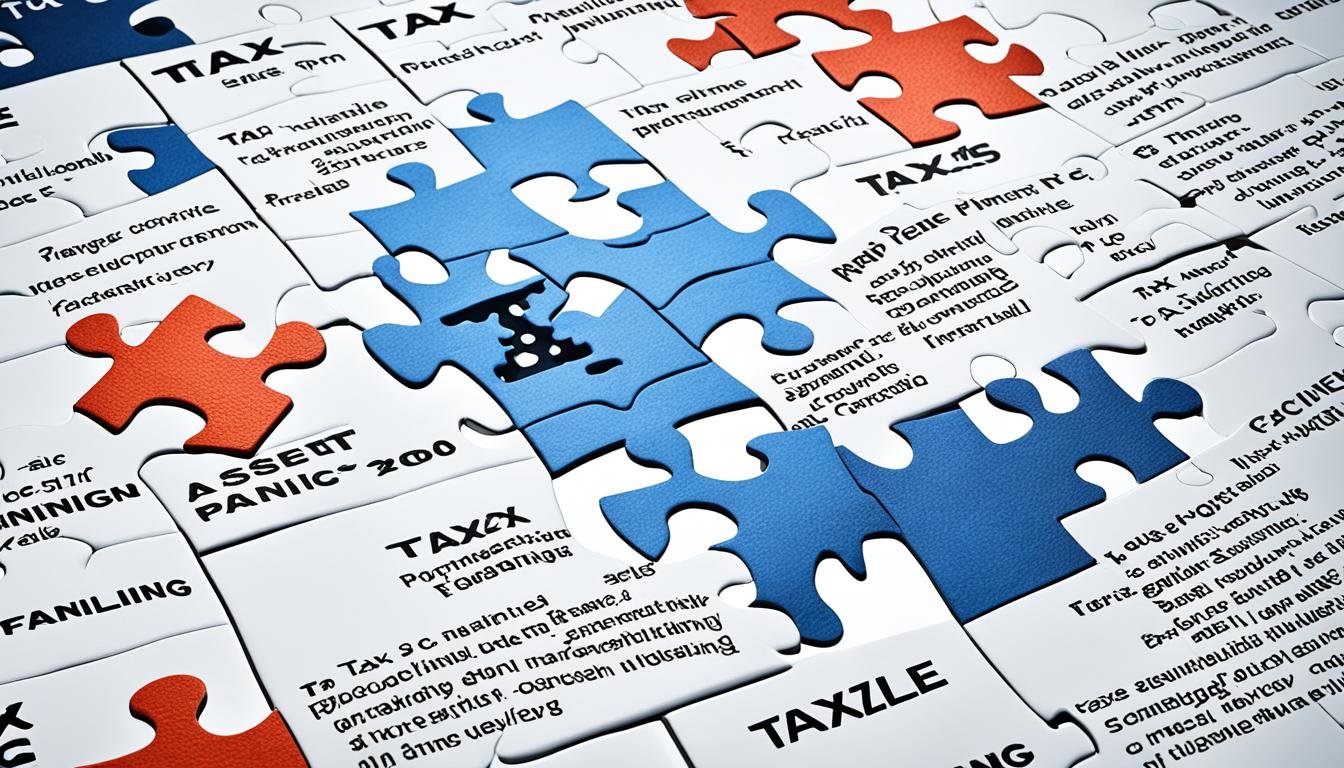How Can Tax Planning Optimize Your Financial Strategy?
Tax planning is crucial for improving your financial strategy and meeting your money goals. Whether you’re a person or a company, it helps use current tax laws to your advantage. This way, you can get more deductions and credits, with lower tax payments. Keeping more of your money allows you to better work towards your financial aims.
The heart of tax planning is finding ways to save on taxes. There are steps like deducting, deferring, dividing, disguising, and avoiding taxes. Using these, you can handle your money smartly. This reduces the tax weight and boosts your financial health.
- Tax planning helps individuals and businesses optimize their financial strategy and achieve their financial goals.
- By maximizing deductions and credits, individuals can minimize their tax liability and increase their disposable income.
- Tax-saving strategies such as deducting, deferring, dividing, disguising, and dodging can be employed to preserve more income for achieving financial objectives.
- Proper tax planning requires staying informed about current tax laws and regulations.
- Consulting with tax professionals and financial advisors can provide valuable guidance for effective tax planning and optimization.
The Key Components of Tax Planning
Tax planning involves several critical aspects for both individuals and businesses to consider. By knowing and using these parts, one can reduce the amount of tax they owe. This means you can better align your financial targets with ways to save on taxes.
Deducting
Deducting is key in tax planning. It’s about making the most of deductions and credits to lower your taxable income. Whether you itemize or take the standard deduction, this step helps lessen what you owe in taxes.
Deferring
Deferring focuses on when you recognize income and pay expenses to delay taxes. This strategy can give you more money in the short term. By timing these right, you might cut your tax bill.
Dividing
Dividing or income splitting means sharing money with family members in lower tax brackets. This can use their lower rates to pay less in taxes overall. Make sure you stay within the rules when splitting income.
Disguising
Disguising your income involves changing it to types taxed at lower rates. Always follow tax laws when using this method. Doing it right can lower your tax bill.
Dodging
In tax planning, dodging means avoiding taxes legally. It’s about managing your money and transactions to pay the least amount of tax while staying within the law. Skillful financial management can help you pay fewer taxes and achieve your financial goals.
Putting all these strategies together forms a strong tax plan. Regularly checking and updating your tax approach is essential. This ensures it stays compliant with new tax laws and rules.
Here is a table to show the key components of tax planning in a clear way:
| Tax Planning Component | Description |
|---|---|
| Deducting | Taking advantage of deductions and credits to minimize taxable income |
| Deferring | Timing income and expenses to delay tax payments |
| Dividing | Shifting money to lower-tax bracket family members through income splitting |
| Disguising | Converting income to types that are taxed at lower rates |
| Dodging | Tax avoidance within the boundaries of the law |
Employing these tax planning components can greatly impact your financial plan. Knowing how to deduct, defer, split, disguise, and dodge taxes can cut your tax bill. This helps individuals and businesses move closer to their financial dreams.
Tax-Planning Strategies for Individuals
You can greatly benefit from different tax strategies. These help boost your financial plan while cutting down what you owe in taxes. With the right deductions, credits, and smart investments, you keep more of your income. Let’s look at some useful strategies.
Maximizing Deductions
Maxing out your allowable deductions is key. Knowing the difference between standard and itemized deductions is vital for this. If you choose to itemize, you can include things like medical costs and donations, which might lead to lower tax obligations.
Utilizing Tax Credits
Don’t overlook tax credits. They lower your tax bill directly, offering more savings than deductions. There are credits for various life situations, like having kids or going to school. Taking advantage of these can save you a considerable amount.
Investing in Tax-Efficient Investments
Tax-efficient investments are a smart choice. They include options such as municipal bonds, Roth IRAs, and HSAs. These investments can help reduce the taxes you pay, leaving you with more from your investments.
Setting Up Tax-Friendly Retirement Accounts
Retirement accounts are great for tax planning. Money put into 401(k)s and IRAs is often untaxed right away. Plus, your earnings grow tax-free until you withdraw in retirement. This can help lower your tax bill significantly.
Exploring Income Splitting Strategies
Paying less by spreading your income among family members in lower tax brackets is a smart move. But, be aware of the rules and ethics around this practice. Getting advice from a tax expert ensures everything is above board.
Putting these strategies to work can really improve your financial position and decrease what you owe in taxes. Maximizing deductions, using tax credits, investing wisely, and considering income splitting are powerful tools. They can lead to better financial health and help you reach your money goals sooner.
Tax-Advantaged Investments and Retirement Planning
Tax-advantaged investments are key for long-term financial success and planning for retirement. By adding them to your investment mix, you get special tax benefits. These can make a big difference in how you plan for the future.
A 401(k) is a great example. Money you put into a 401(k) comes straight from your paycheck before taxes. This lowers your taxable income now and can save you money in taxes. You pay taxes when you take the money out in retirement.
Like the 401(k), the traditional IRA also helps lower your income taxes. You put money in before it gets taxed, which can mean more savings over time. Again, taxes wait until you use the money during retirement.
Then there’s the Roth IRA. It works a bit differently. You pay taxes on the money you put in now, but you won’t pay taxes on it when you take it out later. This could be really good for those who think they might pay more in taxes in the future.
Using these investment types in your retirement plan can help save on taxes and meet your financial goals. Remember, tax laws change. Keep up with these changes and talk to a financial advisor to make the best choices.
Pros and Cons of Tax-Advantaged Investments
Tax-advantaged investments have their good and bad points. Let’s examine them:
| Pros | Cons |
|---|---|
|
|
It’s essential to weigh these points carefully when making investment decisions. Markets, your personal situation, and how much risk you take can all affect the best choice for you.

Tax Planning for Businesses
Small businesses can benefit a lot by using tax planning. This can reduce the money they owe in taxes. By planning their taxes well, businesses can keep more of their earnings. This means they can use the extra money on growth and investments.
A helpful strategy is to use the Qualified Business Income (QBI) deduction. This lets some businesses cut up to 20% off their tax from business earnings. By setting up their business smartly, they can meet the conditions for this deduction.
Businesses can also manage their income and costs to lower taxes. They do this by deciding when to get paid or when to pay bills. This can lower the amount they have to pay in taxes for the year.
It’s also key to plan how investments will affect taxes. By deciding when to sell assets, businesses can lower their tax bills on these sales. This helps them keep more of their investment profits.
Creating retirement plans for employees has tax benefits too. Money put into retirement accounts, like a SEP IRA or a 401(k), can be less taxable. This trims the business’s overall tax bill.
Picking the right business type can also save on taxes. Sole proprietorships, partnerships, and corporations give different tax breaks. Choosing wisely can offer benefits and legal protection.
Using these tax strategies and selecting the best business type can help small businesses with their taxes. Saving on taxes means more resources for growth and success.
Benefits of Tax Planning for Small Businesses:
- Less tax to pay means more money for business activities and investments.
- It can make a company more stable and flexible for market changes.
- Helps attract and keep good employees through strong retirement plans.
- Keeps more profit for growing the business further.
- Helps follow tax rules to avoid penalties and audits.
By using smart tax planning and choosing the right business structure, small companies can save a lot on taxes. This boosts their financial health and helps them succeed in today’s competitive market.
Understanding Tax Planning vs. Tax Optimization
Knowing the difference between tax planning and tax optimization is key in financial and investment decisions. Both aim to boost your money but in different ways related to taxes.
Tax planning is about lowering tax duties in every financial area. This includes your income, what you spend, where you invest, and how you plan your estate or business. The goal is to find legal ways to cut down on taxes through deductions and credits.
Tax optimization zeroes in on how to be smart with your investment and financial moves to pay less tax. It looks mainly at cutting taxes in specific zones, like where your assets are, how you handle investment losses, and picking tax-savvy investments for your future.
*Both methods help you save on taxes and make the most of your money. Tax planning looks at the total financial view, while tax optimization digs into saving through specific tax breaks.*
The Role of Tax Planning
Tax planning is vital for smart money choices. It lets both people and companies:
- Lower their tax burdens
- Use more deductions and credits
- Keep more of their money for their financial dreams
- Stay within tax rules
- Pick the best setup for their business and estate
This planning isn’t just for now. It’s also about strategies that will help you amass and keep wealth in the long run.
The Benefits of Tax Optimization
Tax optimization is all about making investment and money moves that work best for your taxes. This approach has several pluses:
- Picking investments to cut taxes: Smart investment distribution can lower what you pay in taxes, giving you more after-tax earnings.
- Placing assets for less tax: Knowing the best places to put your investments can lower your total tax bill.
- Using investment losses to your tax gain: Offsetting your gains with losses can mean less taxes for you.
- Planning retirement smartly: Thinking about taxes in your retirement plans can help you use your income better later on.
This approach is an ever-moving target. It takes both study of tax laws and the know-how to put complex strategies into action.
“Mixing tax planning and optimization helps people and businesses get a firm grip on their taxes. This leads to more financial gain and a stronger hold on wealth.”
The Synergy of Tax Planning and Tax Optimization
Tax planning and optimization don’t choose sides. They complement each other to craft a full plan for tax efficiency. Together, they let you:
- Lower taxes in all parts of your finances
- Be smarter about your investments for better tax results
- Make the most of deductions, credits, and other tax breaks
- Keep and grow your wealth
- Boost your financial safety for the long term
Merging the strong points of both approaches helps in managing complex tax issues. It guides wise financial choices that meet your goals and dreams.
The Importance of Tax Planning and Tax Optimization
Tax planning and optimization are key for financial success and keeping wealth safe. By using smart tax strategies, people and businesses can cut their taxes, have more money, and follow tax laws to stay financially safe over time.
One main plus of tax planning is finding ways to lower what you owe by claiming deductions and credits. This means your taxable income goes down, giving you a chance for a bigger tax refund. With careful financial planning, you can use the tax system to keep more of your money and improve your financial plan.
Tax optimization lets you change your money moves as your life or business does. You can tweak your investments, how your business is organized, or your retirement savings to fit new tax strategies. This helps you make smart choices that are right for you as things shift over time.
It’s key to do tax planning and optimization the right way, following all laws. It’s smart to get advice from tax experts and financial gurus to make sure your tax moves are lawful and spot-on.
Linking tax plans and optimization with how you manage your money is a forward-thinking way to protect and grow your wealth. By reducing what you owe in taxes and improving your tax standing, you can have more money to reach your big financial goals.
Conclusion
Tax planning and tax optimization are key for both people and companies looking to get the most out of their money. By using smart strategies and choosing investments carefully, you can boost your financial plan. It’s very important to get advice from experts when you need it. Also, keeping track of tax law changes is vital for effective tax planning. With the right approach, you can make your way through the tax system and set yourself up for a prosperous future.







